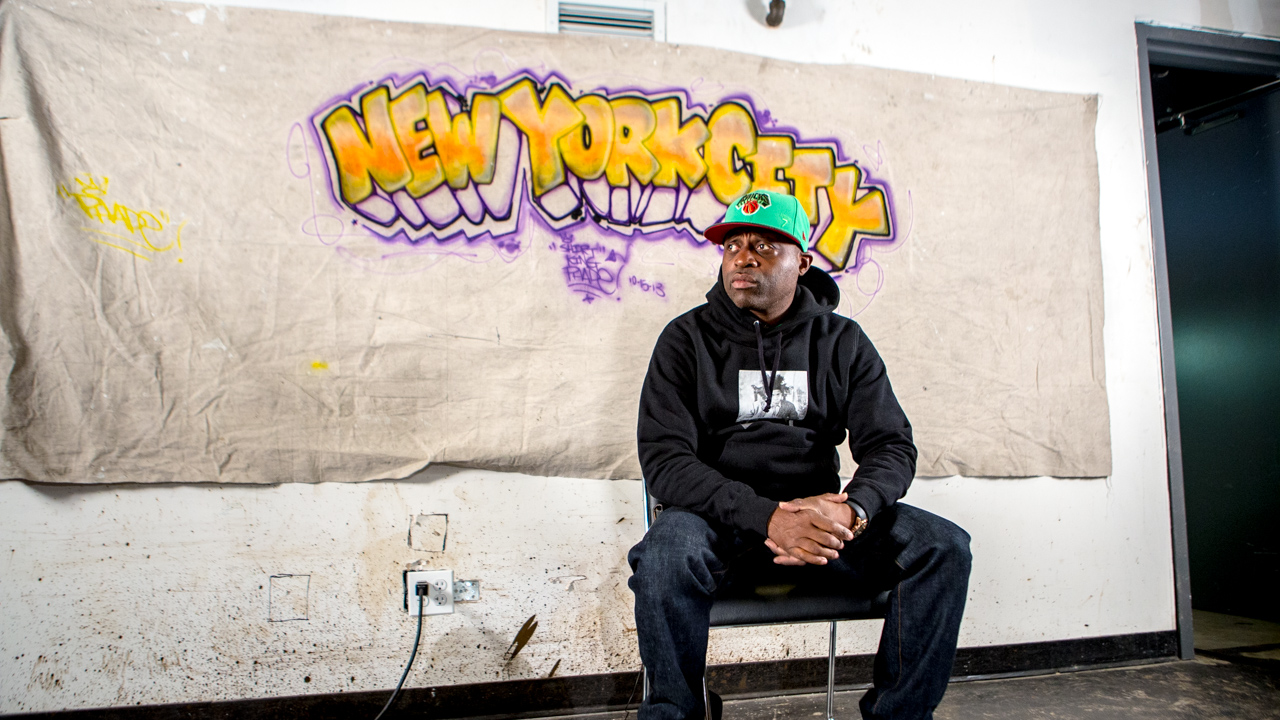Even if you’re not familiar with the Shirt Kings, chances are that you’ve heard of them before in a rap lyric, or seen their work in outfits donned by the likes of LL Cool J, Jay Z, RZA and Jam Master Jay (RIP). The legendary graffiti-inspired art crew from New York pioneered early hip hop fashion. Their custom air brushed designs were the precursor to modern day streetwear, now a $60 billion industry, and are renowned for creating one-off designs for New York personalities who would later reign as the crème de la crème of rap royalty.
Shirt King founder PHADE has written about the origins of his iconic brand in Shirt Kings: Pioneers of Hip-Hop Fashion. He recently spoke to ANIMAL about his book, detailing his early beginnings and how he parlayed the illicit skills he learned from bombing the subway into a very legitimate career.

Born in Brooklyn and raised in the Bronx, Edwin “PHADE” Sacasa, also popularly known as “Shirt King Phade,” said he “officially” started painting trains in 1977. He recalled how he first wrote “PHASE 3” in homage to graffiti pioneer and style master PHASE 2, but was rebuffed by his peers at the High School of Art and Design, an iconic institution attended by some of NYC’s most legendary graffiti writers. He switched up one letter and came up with P-H-A-D-E. A classmate and writer who was more advanced at the time, helped mentor him. “ATOM gave me my first outline,” said PHADE.
Like most writers, he practiced his craft on the insides of subway cars. Once his handstyle was proficient, PHADE started hitting the outsides as well.

PHADE was a teenager when he began hitting the 2 and 5 trains and then expanded to other lines. Here’s how he explained it on graffiti website @149St:
My main lines were the 2s and 5s, but I lived in that 6 tunnel and in that 1 Yard. The Ghost Yard helped me get up on all lines A, B, CC Ds E and F, Gs, J and Ms, Rs, Ns, 1s, 2s etc., etc.
He credits renowned graffiti artists KASE 2, who passed away in August of 2011, with helping him advance his skills. “KASE 2 gave me first burner outline,” said PHADE. This was a huge moment in the young writer’s career: “It changed my life. It brought me into the ranks,” he said. “KASE was the style master and a hard nose. To get anything from him meant something.”

As fun it was painting his name on trains, when he turned 17, PHADE retired from his subway career and quickly found a new pastime to occupy his time: girls. But the itch to paint on things never really left him.
During the early 80s, PHADE discovered airbrushing. It was very much like using spray paint, but he could get even more detailed. He started applying the skills he learned from subway graffiti, and applied them to hoodies and tees instead.
Along with his partners Rafael “Kasheme” Avery and Clyde “Nike” Harewood, who also attended High School of Art and Design, the trio began repurposing all sorts of iconic pop cultural icons — long before the word “streetwear” even existed. They called themselves the Shirt Kings. None of them could have predicted how iconic they’d become.
In the market for a Micky Mouse smoking crack design? They got you. A b-boy Gizmo? No problem. Honing in on the skills learned from graffiti, the Shirt Kings not only did characters, but also could add names and other sayings, making it the most customizable gear on the planet.
Eventually, they started peddling their highly customized wares to people who would go on to make up a who’s who of hip hip, thanks, in part, to an interaction PHADE had with a certain rap icon from Hollis — Queens named Jam Master Jay. Kasheme knew where JMJ lived, so they attempted a little direct marketing and knocked on his door.
At the time, Run-DMC was the most well known hip-hop group in the world. “I’m like wow! This guy I”m seeing on MTV is right here now,” remembers PHADE about the legendary DJ, when he swung open the door. PHADE showed him a custom black shirt he painted a gold chain on. Jay loved it. He advised PHADE to “go to the avenue and open up a shop,” PHADE recalled.
The trio took JMJ’s advice and opened up an airbrushing booth at Coliseum Mall in Queens. “He wore his shirt to Def Jam, but he wouldn’t tell anybody where he got his shirt from,” said PHADE. “So it was sort of like a mystery. I believe one of the first rappers to come through was LL Cool J. He had heard it was in Queens and he was like I’m going to find this.” PHADE says LL wore the gear in several photoshoots for publications and word quickly spread.
“Then a lot of rappers got wind of who we were and what we do,” said PHADE.
Now, the rap iconographers are immortalized not just through images, but through lyrics:
“Used to be the shit, why they have to stop. On the Ave niggas looting all the jewelry spots. Hit the Shirt Kings for an ill airbrush top.” – “Queens Day” by Run-DMC
Yes, yes ya’ll. And it don’t stop.
(Video: Aymann Ismail/ANIMALNewYork)


